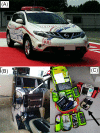Physician-Staffed Emergency Vehicle Crash: A Case Report
- PMID: 35154997
- PMCID: PMC8819582
- DOI: 10.7759/cureus.21027
Physician-Staffed Emergency Vehicle Crash: A Case Report
Abstract
Physician-staffed vehicles are widely operated in many countries. There is a paucity of literature regarding physician-staffed emergency vehicle accidents. On an evening in January 2016, at the request of the fire department, a physician-staffed vehicle was dispatched with two physicians, a nurse, and a driver from the base hospital to the scene of a patient with cardiopulmonary arrest. The vehicle ran with the alerting siren and warning lights. On its way, the vehicle struck a car and the mission was canceled. The patient was transported to another hospital by the ambulance staff only. No passengers were injured. One physician and a nurse examined the driver of the struck car and transported the driver to the base hospital by additional ambulance units. Because there were no manuals or guidelines, the staff responses were not systematic. After the repair of the crashed vehicle and preparation of operation manuals for two months, the physician-staffed vehicle returned to service, and it has worked without any accident since then. The physician-staffed vehicle is of benefit to critical victims and it rarely crashes. When the vehicle is involved in an accident, it results in multiple victims as well as additional emergency demands. Warning lights and sirens in the dark at a four-point crossroads might increase the risk of crashing. Information influx from the emergency scenes might distract the physicians' attention and put stress on the driver, leading to dangerous high-speed emergency driving. Educational training and manuals in each hospital and a nationwide framework regarding safety operations and accidents are needed.
Keywords: health services administration; occupational accidents; occupational injuries; prehospital emergency care; traffic accident.
Copyright © 2022, Abe et al.
Conflict of interest statement
The authors have declared that no competing interests exist.
Figures



Similar articles
-
Does crash risk increase when emergency vehicles are driving with lights and sirens?Accid Anal Prev. 2018 Apr;113:257-262. doi: 10.1016/j.aap.2018.02.002. Epub 2018 Mar 7. Accid Anal Prev. 2018. PMID: 29444480
-
Ambulance Crash in a Rural Area of Thailand.J Emerg Med. 2017 Nov;53(5):730-734. doi: 10.1016/j.jemermed.2017.08.017. Epub 2017 Oct 5. J Emerg Med. 2017. PMID: 28987308
-
Is Use of Warning Lights and Sirens Associated With Increased Risk of Ambulance Crashes? A Contemporary Analysis Using National EMS Information System (NEMSIS) Data.Ann Emerg Med. 2019 Jul;74(1):101-109. doi: 10.1016/j.annemergmed.2018.09.032. Epub 2019 Jan 12. Ann Emerg Med. 2019. PMID: 30648537
-
The Use of Emergency Lights and Sirens by Ambulances and Their Effect on Patient Outcomes and Public Safety: A Comprehensive Review of the Literature.Prehosp Disaster Med. 2017 Apr;32(2):209-216. doi: 10.1017/S1049023X16001503. Epub 2017 Jan 30. Prehosp Disaster Med. 2017. PMID: 28134063 Review.
-
Lights and siren: a review of emergency vehicle warning systems.Ann Emerg Med. 1991 Dec;20(12):1331-5. doi: 10.1016/s0196-0644(05)81076-5. Ann Emerg Med. 1991. PMID: 1746737 Review.
References
-
- Scandinavian pre-hospital physician-manned Emergency Medical Services - same concept across borders? Krüger AJ, Skogvoll E, Castrén M, Kurola J, Lossius HM. Resuscitation. 2010;81:427–433. - PubMed
-
- Structure of rapid response car operations in an urban trauma service. Rehn M, Davies G, Smith P, Lockey DJ. Air Med J. 2016;35:143–147. - PubMed
-
- Prehospital advanced life support provided by specially trained physicians: is there a benefit in terms of life years gained? Lossius HM, Søreide E, Hotvedt R, Hapnes SA, Eielsen OV, Førde OH, Steen PA. Acta Anaesthesiol Scand. 2002;46:771–778. - PubMed
-
- Anesthesiologists in prehospital care make a difference to certain groups of patients. Christenszen EF, Melchiorsen H, Kilsmark J, Foldspang A, Søgaard J. Acta Anaesthesiol Scand. 2003;47:146–152. - PubMed
Publication types
LinkOut - more resources
Full Text Sources
Miscellaneous
